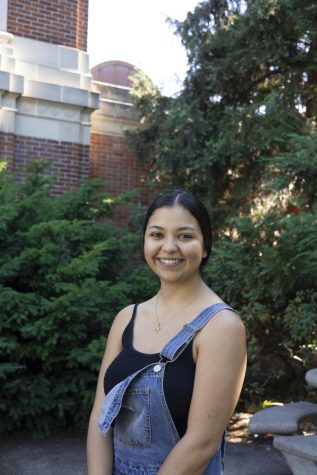OSU native scientists lead three year forest restoration project
A young conifer tree in Avery Park on Nov. 7
November 3, 2022
 Over the next three years, Oregon State University forestry scientists will collect data and collaborate with local Indigenous tribes to find the best methods to preserve forests in the western Oregon.
Over the next three years, Oregon State University forestry scientists will collect data and collaborate with local Indigenous tribes to find the best methods to preserve forests in the western Oregon.
The restoration effort, led by Christina Eisenberg, just received $5 million in funding from the U.S. Department of the Interior. Efforts will focus on the soil, understory, surrounding trees and the wildlife in each of the forests being surveyed.
At the forefront of the project is the team’s commitment to Traditional Ecological Knowledge, said Christina Eisenberg, principal investigator on the project and Associate Dean for Inclusive Excellence and Director of Tribal Initiative in the OSU College of Forestry.
She described TEK as a philosophy with two major underpinning concepts. The first is cultural humility: that humans are embedded in nature and not superior to nature, and the second being reciprocity, which is a means of taking from nature what is only absolutely necessary.
“There’s a third thing, the ‘seventh generation approach’ to life,” Eisenberg said. “That means that whatever you do in this world, to do it keeping in mind how your actions are affecting the world moving forward seven generations in the future.”
Eisenberg herself is Apache and Rarámuri, and finds her personal commitment to the land and wishes of local tribes to be critical to the project’s success. Potential tribal partners in the project include the Confederated Tribes of Coos, Lower Umpqua and Siuslaw Indians, the Confederated Tribes of the Grand Ronde, the Confederated Tribes of the Siletz, the Coquille Indian Tribe and the Cow Creek Band of the Umpqua Indians.
Through collaboration with the tribes that live within the forests subjected to analysis, Eisenberg hopes that her team can learn traditional methods of conservation as well as what traditional plants and organisms are crucial to native land.
“The native communities there face a lot of challenges and went through horrible things as a result of settler colonialism and they’re recovering from that. So, a project like this would be really beneficial to them,” Eisenberg said.
The first groups of OSU scientists will enter any one of forests enrolled in the project within the next few months.
Allison Monroe, PhD student in the College of Forestry, will be working alongside Eisenberg, who is her major professor. Monroe is also native — Cherokee — and her work will surround entomology, working to find ways to understand the biodiversity of insects and pollinators within the forests.
“I try to understand relationships and express those through western science and use both the knowledge that we gain from both Indigenous knowledge and Western science to find a way forward using the strengths of both of those ways of knowing,” Monroe said.
She and Eisenberg met while working on a similar project led by Eisenberg through the University of Montana this past July. After realizing how similar their interests of study were, Monroe quickly applied to OSU’s masters program in the College of Forestry.
Monroe received a National Science Graduate Research Fellowship while she did an internship at the University of Montana and specifically mentioned on her application that it was in her career goals to become a professor. When she heard back from OSU admissions, she was offered to start a PhD track instead.
Shortly after, she was asked to join the restoration efforts alongside Eisenberg.
“I am honored to get to learn from an Indigenous woman in science like Cristina and to get to learn how to be my most authentic self in academia,” Monroe said. “Learning how to be everything my ancestors were told they couldn’t be… with that comes the responsibility to uplift all the other Indigenous scientists that are going to help us in this project.
Another researcher on the project is Tom DeLuca, who is a soil scientist. DeLuca specializes in the damaging effects of wildfires on soil within forests and will continue that research within the next three years.
Through collection of soil samples, DeLuca will focus on carbon turnover in soil, and how quickly the soil bounces back following extreme wildfire damage.
“The challenging thing with soils is like, when you look across a landscape you can see trees, you can measure them, you can measure the understory and that type of thing,” DeLuca said. “With soils, it is out of sight, out of mind…the answers are hard to come up with.”
Other scientists a part of this effort include the Cheryl Ramberg-Ford and Allyn C. Ford Dean of the College of Forestry; Chris Dunn, a fire ecologist in the college; restoration ecologist Tom Kaye, director of the Institute for Applied Ecology; and soil scientist Si Gao of Sacramento State University.











































































































